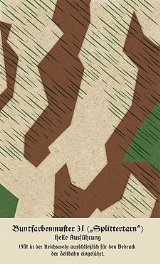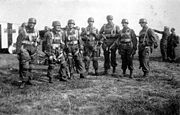
Splittermuster
Encyclopedia
Splittermuster was a four-colour military camouflage
pattern developed by Germany
in the late 1920's, and was first issued to the Reichswehr
in 1931. It was first printed on the newly designed and issued triangular tent/poncho called the dreieckszeltbahn. Known in German
as Buntfarbenaufdruck (Colourful print) 31 for its year of introduction, splittermuster was issued on a very wide basis to practically all regular military (Wehrmacht) units. The pattern consists of a disruptive pattern of hard-edged wood-brown and medium green polygons printed on a light field-grey or tan background. A random pattern of green dashes, called raindrops, was applied in places to improve the camouflage effect.
Proposed in 1931 and introduced in 1932, the four-colour camouflage patterns incorporated "splinters" on top of the 1918 colour pattern. This pattern included ochre, rust, brown overlaid on a green foundation, with sharp corners between coloured patches. This new pattern was printed on zeltbahn (triangular tent) material, and could also be used as a camouflage rain poncho in the field. Both sides of the material showed the same pattern, but the printing was brighter on one side.
A subdued grey-beige tint replaced the yellow ochre colour. On top of this background, green and brown irregular patterns were screen-printed. A final innovation applied to this camouflage colour printing were the "splinters" ("splinter Tarn") irregularly printed on the fabric. Directional, dark green dashed lines ("grass") were printed in selected areas to help break up the silhouette. During the war, cost-saving measures required textiles to be printed with different colours. In addition, many of the lower-cost two-colour options were abandoned. These cost-saving measures caused significant deviations from the original colour patterns.
Equipment in the stained colour printing units were issued to the following:
.jpg) The zeltbahn was the only official Army camouflage until 1942 when the Tarnhemd (smock) and Tarnhelmüberzug (helmet cover), both of a lightweight herringbone twill linen. Only one side of each was printed in splittermuster while the other side was left white for snow camouflage.
The zeltbahn was the only official Army camouflage until 1942 when the Tarnhemd (smock) and Tarnhelmüberzug (helmet cover), both of a lightweight herringbone twill linen. Only one side of each was printed in splittermuster while the other side was left white for snow camouflage.
In April 1942 a Wintertarnanzug suit consisted of a padded jacket, trousers, separate hood and mittens. These were also printed only on one side and were left white on the other side. However, only a small amount of these were produced, a similar set made in mouse grey or field grey were more common.
Many unofficial garments and helmet covers were produced as field expedients or were tailor made, mostly from zeltbahn material. These included versions of the service dress uniform, Parachute jump smocks, field jackets, rucksacks and panzer jackets. Later materials included rayon
.
 Luftwaffe-Splittermuster 41 is a Luftwaffe
Luftwaffe-Splittermuster 41 is a Luftwaffe
version with a smaller splinter and a more complicated pattern, from probably not earlier than 1941. The Luftwaffe's variant of splittermuster 31 is known in the literature as "splinter camouflage B". The main difference to the 1931 splinter camouflage is that the smaller factions spots. The complexity of these spots is obvious. The pattern was used for the Fallschirmjäger
's parachute Knochensack
jump smock and Luftwaffe Field Division
field jacket to be manufactured. Other material produced with this equipment included camouflage helmet covers, ammunition bandolier
s, grenade bags, and helmet covers. The production of the splinter camouflage B ended in 1944.
Camouflage
Camouflage is a method of concealment that allows an otherwise visible animal, military vehicle, or other object to remain unnoticed, by blending with its environment. Examples include a leopard's spotted coat, the battledress of a modern soldier and a leaf-mimic butterfly...
pattern developed by Germany
Germany
Germany , officially the Federal Republic of Germany , is a federal parliamentary republic in Europe. The country consists of 16 states while the capital and largest city is Berlin. Germany covers an area of 357,021 km2 and has a largely temperate seasonal climate...
in the late 1920's, and was first issued to the Reichswehr
Reichswehr
The Reichswehr formed the military organisation of Germany from 1919 until 1935, when it was renamed the Wehrmacht ....
in 1931. It was first printed on the newly designed and issued triangular tent/poncho called the dreieckszeltbahn. Known in German
German language
German is a West Germanic language, related to and classified alongside English and Dutch. With an estimated 90 – 98 million native speakers, German is one of the world's major languages and is the most widely-spoken first language in the European Union....
as Buntfarbenaufdruck (Colourful print) 31 for its year of introduction, splittermuster was issued on a very wide basis to practically all regular military (Wehrmacht) units. The pattern consists of a disruptive pattern of hard-edged wood-brown and medium green polygons printed on a light field-grey or tan background. A random pattern of green dashes, called raindrops, was applied in places to improve the camouflage effect.
Proposed in 1931 and introduced in 1932, the four-colour camouflage patterns incorporated "splinters" on top of the 1918 colour pattern. This pattern included ochre, rust, brown overlaid on a green foundation, with sharp corners between coloured patches. This new pattern was printed on zeltbahn (triangular tent) material, and could also be used as a camouflage rain poncho in the field. Both sides of the material showed the same pattern, but the printing was brighter on one side.
A subdued grey-beige tint replaced the yellow ochre colour. On top of this background, green and brown irregular patterns were screen-printed. A final innovation applied to this camouflage colour printing were the "splinters" ("splinter Tarn") irregularly printed on the fabric. Directional, dark green dashed lines ("grass") were printed in selected areas to help break up the silhouette. During the war, cost-saving measures required textiles to be printed with different colours. In addition, many of the lower-cost two-colour options were abandoned. These cost-saving measures caused significant deviations from the original colour patterns.
Equipment in the stained colour printing units were issued to the following:
Heeres-Splittermuster 31
.jpg)
In April 1942 a Wintertarnanzug suit consisted of a padded jacket, trousers, separate hood and mittens. These were also printed only on one side and were left white on the other side. However, only a small amount of these were produced, a similar set made in mouse grey or field grey were more common.
Many unofficial garments and helmet covers were produced as field expedients or were tailor made, mostly from zeltbahn material. These included versions of the service dress uniform, Parachute jump smocks, field jackets, rucksacks and panzer jackets. Later materials included rayon
Rayon
Rayon is a manufactured regenerated cellulose fiber. Because it is produced from naturally occurring polymers, it is neither a truly synthetic fiber nor a natural fiber; it is a semi-synthetic or artificial fiber. Rayon is known by the names viscose rayon and art silk in the textile industry...
.
Luftwaffe-Splittermuster 41

Luftwaffe
Luftwaffe is a generic German term for an air force. It is also the official name for two of the four historic German air forces, the Wehrmacht air arm founded in 1935 and disbanded in 1946; and the current Bundeswehr air arm founded in 1956....
version with a smaller splinter and a more complicated pattern, from probably not earlier than 1941. The Luftwaffe's variant of splittermuster 31 is known in the literature as "splinter camouflage B". The main difference to the 1931 splinter camouflage is that the smaller factions spots. The complexity of these spots is obvious. The pattern was used for the Fallschirmjäger
Fallschirmjäger
are German paratroopers. Together with the Gebirgsjäger they are perceived as the elite infantry units of the German Army....
's parachute Knochensack
Knochensack
Knochensack was the nickname for German parachute jump smocks designed to wear over a paratrooper's equipment made for the Luftwaffe Fallschirmjäger during World War II. They were made in a variety of camouflage patterns and made from tough cotton material.There were several models in use in 1936,...
jump smock and Luftwaffe Field Division
Luftwaffe Field Division
The Luftwaffe Field Divisions were German military formations which fought during World War II.-History:...
field jacket to be manufactured. Other material produced with this equipment included camouflage helmet covers, ammunition bandolier
Bandolier
A bandolier or a bandoleer is a pocketed belt for holding ammunition. It was usually slung over the chest. In its original form, it was common issue to soldiers from the 16th to 18th centuries. This was very useful for quickly reloading a musket....
s, grenade bags, and helmet covers. The production of the splinter camouflage B ended in 1944.
See also
- Eichentarn
- Flachentarn (First NVA pattern)
- FlecktarnFlecktarnFlecktarn is a 3-, 4-, 5- or 6-colour disruptive camouflage pattern. The use of spots creates a "dithering" effect, which eliminates hard boundaries between the different colours in much the same way the squares in the newest digital camouflage patterns do...
- LeibermusterLeibermusterLeibermuster was a six-color military camouflage pattern developed by the Third Reich in February 1945. Known in German as "Buntfarbenaufdruck 45" for its year of introduction, Leibermuster was issued on a very limited basis to combat units before the war ended. It was the first pattern issued...
- Sumpftarn (Also known as BGS pattern)
- Strichtarn
- Tarnmuster
- Tarnkleidung

